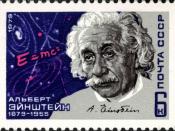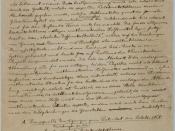E=mc"
Born in 1879 in Ulm, Württemberg, Germany, Albert Einstein was considered a quite child who was raised by his German Jewish family.
Einstein's formula, which describes the relationship between energy (E), mass (m) and the speed of light (c), derives from Einstein's special theory of relativity. This theory postulates that time and space are relative, how we measure time and space depends on our state of motion relative to other observers. The formula E=mc" first appeared in an article by Einstein in 1905, using a different notation, and in 1907 he fully generalized the concept to the equivalence of mass and energy. The implication of the formula thus became that a small amount of matter could, in principle, be converted into a vast amount of energy.
The realization of this principle in practice became a possibility in the 1930's with the discovery of nuclear fission, which led ultimately to the development of nuclear weapons.
After the Second World War, Einstein's formula became synonymous with the nuclear age.
Einstein completed the general theory of relativity in 1915 and published this first exposé the following year. The general theory overturned Newton's theory of gravity, which had been valid for two hundred and fifty years. In Newton's universe, gravity was regarded as an attractive force, which all massive bodies exert on each other. The planets moved in elliptical orbits about the sun because of its great mass powerful gravitational force. In Einstein's universe, gravity is not regarded as an exterior force, but rather as a property of space and time or "space-time". Einstein's curved four-dimensional space-time "continuum" is often likened to a suspended rubber sheet stretched taut but deformed wherever heavy objects - stars, galaxies or any other matter - are placed on it. Thus, a massive body like the sun...


